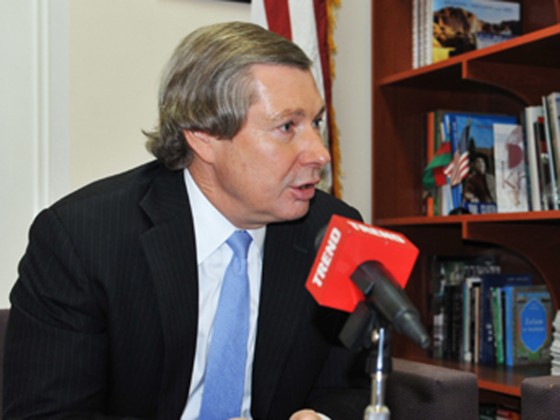
The OSCE Minsk Group co-chairs, brokering talks over a resolution to the Nagorno-Karabakh conflict, are scheduled to visit the region on October 28 to moderate a meeting of the Azerbaijani and Armenian presidents.
During the planned trip to the region this week, the OSCE Minsk Group co-chairs expect to secure commitments from the two presidents to participate in a summit before the end of the year.
“If they are committed to a negotiated settlement, then it is critical for them to meet to discuss key issues,” James Warlick, the US co-chair of the OSCE Minsk group told AzerNews.
Warlick was commenting on the level of preparations required for the expected meeting of Azerbaijani President Ilham Aliyev and Armenian President Serzh Sargsyan.
OSCE Minsk Group co-chairs Warlick, Igor Popov (Russia) and Pierre Andrieu (France) will visit the region on October 28.
On the other hand, Warlick voiced disappointment that there has been no presidential meeting for over a year.
“We are disappointed that it has been more than one year since the presidents last met to discuss the Nagorno-Karabakh conflict, despite having promised each other to intensify their dialogue,” he said.
The latest meeting between President Aliyev and President Sargsyan took place in France last October.
The Paris talks were expected to bring some breakthrough in the stalled conflict, but Armenia’s provocative actions and intensive ceasefire violations have aggravated the situation even more.
Furthermore, Warlick hoped the sides would demonstrate the political will to make a significant breakthrough in the meeting.
He has considered that the time has come to settle the Nagorno-Karabakh conflict, which is a big hindrance for the development of the region and a source of torment for people suffering from the bloody war.
“Every meeting of the presidents is valuable, but it’s not enough. We have called not only for discussions on the presidential level, but also for structured negotiations where the sides can work through the many complicated issues that would be part of a settlement. At the next summit, we hope the presidents will demonstrate flexibility and the political will to reach a settlement. The time is now and the people of both countries deserve to live side by side in peace and security,” Warlick said.
He also shared the view of many experts and officials that the Nagorno-Karabakh conflict is not a frozen conflict.
“We share the view that the Nagorno-Karabakh conflict is not frozen, and that is exactly why the co-chairs continue their active engagement with the sides to advance negotiations on a resolution,” he said.
The recent skirmishes between Armenian and Azerbaijani troops on the contact line have raised the likelihood for the resumption of military operations.
Warlick assured that work is underway for a peaceful resolution of the long-lasting conflict.
“The co-chairs are working with the sides on elements of a settlement, and have proposed numerous confidence-building and people-to-people measures to complement the negotiation process,” he said.
For over two decades, Azerbaijan and Armenia have been locked in conflict that emerged over Armenia’s territorial claims against its South Caucasus neighbor. Since a war in the early 1990s, the Armenian armed forces have occupied 20 percent of Azerbaijan’s territory, including Nagorno-Karabakh and seven surrounding regions.
A fragile ceasefire has been in place since 1994, but long-standing efforts by US, Russian and French mediators have been largely fruitless so far.
Armenia has not yet implemented the UN Security Council’s four resolutions on its pullout from the neighboring country’s territories.
Trend
